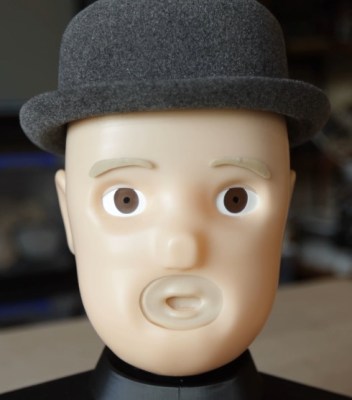Many decades ago, IBM engineers developed the typeball. This semi-spherical hunk of metal would become the heart of the Selectric typewriter line. [James Brown] has now leveraged that very concept to create a pivoting mouth mechanism for a robot that appears to talk.
 What you’re looking at is a plastic ball with lots of different mouth shapes on it. By pivoting the ball to different angles inside the head of a robot, it’s possible to display different mouth shapes on the face. By swapping mouth shapes rapidly in concert with recorded speech, it’s possible to make the robot appear to be speaking. We don’t get a great look at the mechanism that operates the ball, but Selectric typeball operation is well documented elsewhere if you seek to recreate the idea yourself.
What you’re looking at is a plastic ball with lots of different mouth shapes on it. By pivoting the ball to different angles inside the head of a robot, it’s possible to display different mouth shapes on the face. By swapping mouth shapes rapidly in concert with recorded speech, it’s possible to make the robot appear to be speaking. We don’t get a great look at the mechanism that operates the ball, but Selectric typeball operation is well documented elsewhere if you seek to recreate the idea yourself.
The real benefit of this mechanism is speed. It might not look as fluid as some robots with manually-articulated flexible mouths, but the rapid mouth transitions really help sell the effect because they match the pace of speech. [James] demonstrated the finished product on Mastodon, and it looks great in action.
This isn’t the first time we’ve featured [James Brown]’s work. You may recall he got DOOM running on a tiny LEGO brick a few years back.
Thanks to [J. Peterson] for the tip!















He consistently builds the most mind-blowing stuff.
I would love to see the mechanism. Very much a Clutch Cargo vibe.
I immediately thought about uncanny valley, which Clutch Cargo fell deeply into. This stays on the distinctly mechanical side.
Also used here:
https://i0.wp.com/www.cancelledscifi.com/wp-content/uploads/2021/06/The-Amazing-Screw-On-Head-Lincoln.jpg?ssl=1
Bill Hammack has a video on the principle:
“IBM Selectric Typewriter & its digital to analogue converter” – https://www.youtube.com/watch?v=bRCNenhcvpw
The IBM Selectric may be the last, great, mechanical device. The only non-mechanical part in it is an electric motor.
Bill’s video is quite cool. I know the general principle, and am familiar with the selectric mechanism from back when modified selectrics were used as computer terminals/letter quality printers (I did a lot of the routine work on them at the uni computing center), and another post showed a stepper motor for rotation, but no detail of how the tilt is accomplished.
Cool, i love this kind of out of the box thinking.
Oh, try with Thomas the tank engine.
If I were a stop motion animator, I think I’d probably want to talk to [James] (using an actual mouth).
This reminds me of Lincoln’s “webcam” in The Amazing Screw-On Head https://youtu.be/BjqYHSQwtQg?si=bJRH_z4K-O2v4gYT
Thanks. I hate it.
New DND monster unlocked
Awesome. Would also love to see a video of the cool cat clock seen in the background
https://youtu.be/fSlaXXyRvU4?si=iYqNty-WeicV3EKR